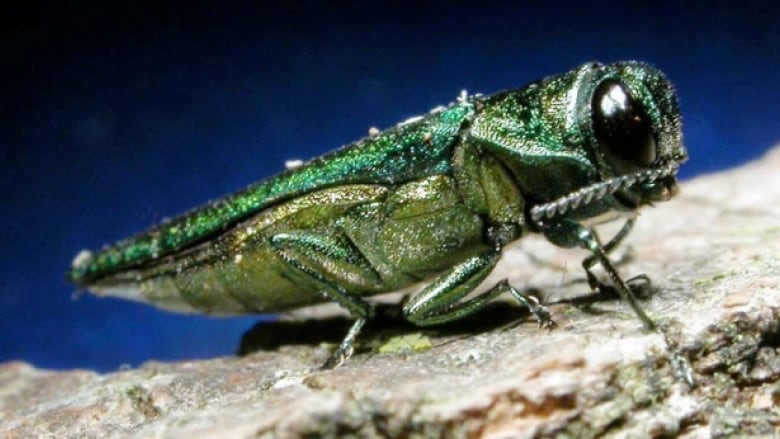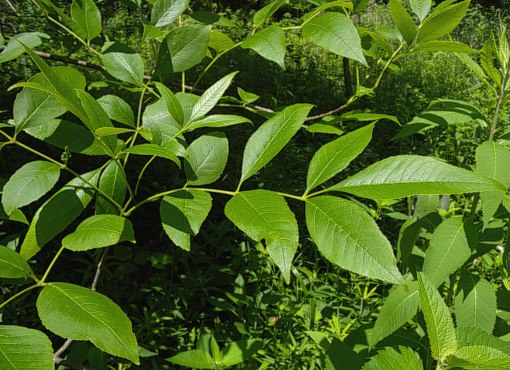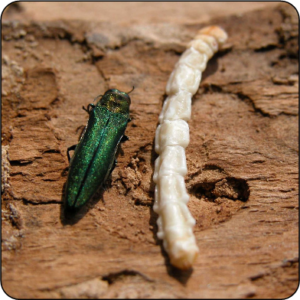We had talked about lilac ash borer in a previous post but there is an even greater threat looming from the East. Emerald ash borer is an ash tree killer from East Asia that made its way to North America in the 1990’s. Since then, it has killed millions of ash trees in eastern Canada and the United States. It has made its way as far as Manitoba and is expected to eventually invade Alberta. While lilac ash borer weakens its host, leaving it vulnerable to other attackers or diseases, the emerald ash borer kills the tree outright by girdling the tree.
The Problem
Emerald ash borer or Agrilus Planipennis is a small, metallic green beetle that targets all ash trees. The adult beetles burrow out of their hosts in late May or early June, leaving distinctive D-shaped exit holes. For the next two weeks they look for mates and lay eggs. The eggs are laid in bark crevices or under bark scales where they incubate for 1-2 weeks, depending on conditions. After hatching, the larvae burrow straight down into the bark until they reach the inner layer between the bark and wood. Once there, they will dig winding S-shaped galleys as they feed and go through four molts. After the fourth molt the larvae will dig a burrow into either the wood or bark and settle in a tightly folded J-shape to pupate. In warmer climates they pupate for one winter and emerge as adults in the late spring, but in colder climates they need a second winter before finishing their pupation.

The Victims
Emerald ash borer targets all ash trees both native and exotic, aside from mountain ash. Mountain or rowan ash is not a true ash tree but rather, part of the rose family.
Green ash is fast growing and can reach around 55 ft tall and 25 feet wide. They grow upward with a singular trunk and their branches grow opposite from another. Young ash bark is smooth and greyish with red streaks while mature ash bark is dark grey with diamond shaped irregular ridges. Green ash leaves are pinnately compound with 5-9 leaves coming off a single stalk. Mature green ash branches often droop downwards.
Black ash is very similar to green ash. Black ash leaves have no petiole and connect directly to the leaflet stalk. Black ash usually has 9 or 11 leaves per leaflet while green ash has 7 or fewer. Black ash bark is more flakey than green ash and is more plated rather than ridged. Black ash branches grow more upright compared to green ash.

The Signs & Symptoms
Infested trees often do not show obvious symptoms until there is a significant amount of borer present. Symptoms include branch die back starting with chlorosis that starts at the top of the crown. Deformed or discolored bark and excessive epicormic growth are also symptoms of Emerald ash borer. Very heavy seeding can be a symptom of emerald ash borer infestation, as most trees will seed excessively when stressed. (Elm trees seed heavy even when they are not stressed so don’t worry about them)
You can see the signs of infestation before the symptoms, but it can be hard to detect. Adult borers leave D-shaped holes in the tree when exiting, sawdust or frass can be found around the bore site or on the ground with heavy infestations. Bark can be stripped from the trunk to reveal the galleys and borer larvae under the surface.

What Can Be Done
When heavily infested the tree is usually too far gone to be saved. The tree may have life still, but it is irreversibly declining and serving as a home for the borer. In this case it is advised to remove infested trees completely and treat the rest against emerald ash borer.
Ash trees can be treated to be resistant to emerald ash borer with insecticide injections.
Keeping your trees healthy can only help but in the case of most invasive tree pests they do not target weak trees exclusively. Emerald ash borer will target any ash no matter its health, size, or age. A healthy tree will be better able to survive in the early stages of infestation, giving you a better chance of saving the tree.
What Kentucky Blue Grass Can Do
We can provide professional tree assessments, prune for better health, treat ailments, water, fertilize, and remove trees, as necessary.
We also provide organic insecticide injections called Treeazin that can make trees resistant to emerald ash borer. Treeazin is Canadian invented and owned.
https://bioforest.ca/en/canada/product-details/treeazin-systemic-insecticide/
Professional Reference
Denise Allan, ISA Certified Master Arborist, March 7, 2021.
https://www.invasivespeciesinfo.gov/terrestrial/invertebrates/emerald-ash-borer
https://www.ontario.ca/page/emerald-ash-borer
https://www.nrcan.gc.ca/forests/fire-insects-disturbances/top-insects/13395
https://entomologytoday.org/2016/03/07/heres-how-to-inspect-your-trees-for-emerald-ash-borer/


Comments are closed